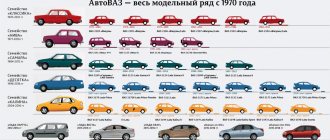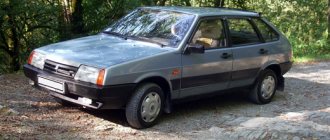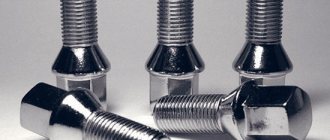On April 19, 1970, the first Zhiguli cars rolled off the main assembly line of the Volzhsky Automobile Plant. It was a VAZ-2101 model, popularly nicknamed “kopeyka”. After it there were five more models from the “classic” series, one Oka, a dozen Ladas. All these cars are not twins at all. Each VAZ has significant differences that are worth clearly seeing.
- Oka (1987—2008)
- LADA Samara family
- Family "ten"
VAZ-2110 (1995–2010)
- VAZ-2111 (1997–2010)
- VAZ-2112 (1998–2008)
- VAZ-1117 (2004–2018)
Classic Lada
The classic Zhiguli family consists of seven models of rear-wheel drive small class cars. There are two body types in the lineup - a four-door sedan and a five-door station wagon. All models are distinguished by a laconic design - now the appearance of Ladas may seem rustic, but for their time classic VAZs were quite stylish Soviet cars.
This infographic shows how the appearance of AvtoVAZ cars has changed from 1970 to 2022
VAZ-2101 (1970–1988) - the foreign public knew the model as LADA-120. It is a four-door sedan. The “penny” took away all external features from its Italian counterpart:
- cubic body shape (still with rounded corners, while subsequent models will become more “chopped”);
- a simple “facade” with a rectangular grille and a round pair of headlights;
- high roof line;
- rounded wheel arches;
- a laconic “rear” with vertically oriented lights and a small trunk lid.
The prototype for the first VAZ was the Fiat 124 (and quite legally, since an agreement was signed between the owner of the Italian concern and the Soviet Vneshtorg)
VAZ-2102 (1971–1986) - the five-door station wagon turned out to be spacious. In addition to the changed body type, the “two” is distinguished from the “kopek” by the license plate located on the fifth door and vertical rear lights.
The trunk of the VAZ-2102 could accommodate a lot of luggage (therefore, the car was the dream of every Soviet summer resident, fisherman, hunter and tourist)
VAZ-2103 (1972–1984) - the third model of the Lada (Lada 1500 in the export version) was launched from the assembly line in the same year as the “two”. The three-ruble note can be easily distinguished from the VAZ-2102, since they have different body types. But the large radiator grille with twin headlights “sitting” directly on it will help distinguish the VAZ-2103 from the previous sedan (“penny”).
Over 12 years, 1,304,899 of these Zhiguli “three rubles” were produced
VAZ-2104 (1984–2012) - station wagon, known in the West as Kalinka. The main difference from its predecessors is not round, but rectangular headlights. The lines of the body are more chopped (the roundings at the corners have become less pronounced than, for example, the “kopek”).
This five-door car demonstrates the classic Zhiguli design; The VAZ-2106 is larger than the “two” - it is 42 cm higher, and the luggage compartment is 112 cm longer
If the VAZ-2104 is the first domestic station wagon with rectangular headlights, then the VAZ-2105 is the first sedan with a similar form of optics. The body of the “five” is distinguished by its greater angularity. On the side there are wings with cut contours. The roof does not have a hint of rounding, the hood and luggage compartment are longer than those of a “kopek” or “troika”.
Export cars were called LADA-2105 Clasico; Soviet car enthusiasts nicknamed the car “stool”; “five” was liked by Soviet citizens who did not want to buy a station wagon, but wanted to have a car with a spacious trunk
VAZ-2106 (1976–2006) - popularly nicknamed the “Lada Six”; for foreign buyers the name Lada 1600 was used - a rear-wheel drive four-door sedan. A special feature of the VAZ-2106 is a round pair of headlights, “planted” not on the radiator grille, but in black plastic rectangles.
The VAZ-2106 became the most purchased car of the seventies and eighties in the USSR (in total, over 4.3 million “sixes” were produced and sold, while “threes” produced 1.3 million copies, and “fives” - 1.8 million)
VAZ-2107 (1982–2012) was made in accordance with the automotive trends of the eighties. At that time, angular, even slightly rough shapes, an abundance of chrome parts, and protruding parts (like the radiator grille, which began to protrude from the level of the hood) were fashionable. Like the VAZ-2106, the headlights are set in plastic rectangles (the difference is that the “six” has round front optics, while the “seven” has rectangular ones).
American automobile journalist Jeremy Clarkson, reviewing the VAZ-2107, called the car “a car for rude men who cannot tolerate anything feminine”
VAZ 2103 engine design
The VAZ 2103 engine design is a classic engine with an overhead gas distribution mechanism, which has a high cylinder block. The VAZ 2103 carburetor has a distributor with a vacuum ignition timing regulator. The height of the engine is 215.9 mm instead of 207.1 (for the VAZ 2101). This made it possible to increase the working volume to 1.5 liters and use a crankshaft with an increased piston stroke.
The VAZ 2103 cylinder block is cast from special cast iron. The center-to-center distance is 95 mm, which makes it possible to increase the cylinder diameter from 76 to 79 mm. The cylinder head is made of aluminum alloy and its height is 112.5 mm.
To drive the gas distribution mechanism (GRM), a double-row bushing-roller chain with 116 links is used. There is no chain tensioner. To drive the generator and water pump, a V-belt with a cross-section of 10×8 mm and a length of 944 mm is used. The crankshaft has a crank radius of 40 mm and provides a piston stroke of 80 mm.
The pistons and valves of the VAZ 2103 model are similar to the pistons and valves of the 2101 model. The pistons are made of aluminum alloy with the outer surface coated with tin. Piston rings are made of cast iron. The barrel-shaped surface of the upper compression ring is chrome-plated. The lower compression ring is strengthened by phosphating. The oil scraper ring has an expander spring, ground at the ends and along the outer diameter.
Oka (1987—2008)
VAZ-111 (Lada Oka) is a Russian ultra-small class car. About 700 thousand models were rolled off the assembly line. The body type is a three-door hatchback. In an effort to reduce the size of the car, the developers sacrificed the harmonious appearance, which is why Oka was popularly nicknamed “Cheburashka”. Characteristic appearance features:
- miniature body;
- angular lines;
- rectangular optics;
- bumper made of unpainted plastic;
- shortened overhangs;
- short wheel arches;
- roof pillars too thin;
- large glass area.
Oka is 3200 mm long, 1420 mm wide, 1400 mm high
What is the difference?
| VAZ-2103 | VAZ-2106 | |
| Working volume, cubic meters m | 1451 | 1570 |
| Acceleration of the 1st hundred m, s | 19, i.e. a bit better | 18 |
| Max speed, km/h | 150 | 154 |
| Power, hp | 75 | 80 |
| Weight, kg | 1030 | |
| Lattice | Metal from edge to edge | Only between the headlights and later became plastic |
| Headlights | The distance within each pair is smaller | In a special recess |
| Bumper | With "fangs" | ‑ |
| Turn signals | Usually diamond shaped | Rectangular |
| Lanterns | More primitive, only 2 colors | More difficult |
| Nameplate | Rounded top and bottom lines | Rectangular |
| Cost, rub. | 7500 | 9100 |
LADA Samara family
In 1984, the Volzhsky Automobile Plant decided to carry out a complete restyling of its VAZs and released the Lada Samara (aka VAZ-2108). In 1987, another model of this family was presented to the public - the VAZ-2109. The differences between the Samara and the classic Zhiguli were colossal, which divided Soviet citizens: some were outraged by the changed appearance of VAZs, others praised the manufacturers for innovations that separated domestic cars from the progenitor Fiat 124.
Initially, in the domestic market this line of VAZs was called “Sputnik”, and the name Lada Samara was used only for export cars
VAZ-2108 (1984–2003) - the three-door hatchback VAZ-2108 was popularly nicknamed “chisel” and “crocodile” for its elongated, narrowed front part. The car is spacious, as it was intended to be used as a family car. The body of the Samara is more rigid and, accordingly, safer than the “classics”. The rear seats are made with children in mind, and the trunk is spacious.
For the first time in the VAZ model range, VAZ-2108 began to be painted with metallized enamels in mass production
The VAZ-2109 (1987–2004) differs from the VAZ-2108 in that it is a five-door rather than a three-door hatchback. There are no other significant differences in appearance.
The width and length of the VAZ-2109 are the same as those of the VAZ-2108, and the height is an insignificant 4 cm greater
Can the interior of the “six” surprise?
In 1976, no one thought about the presentability of the interior of the VAZ-2106. Thin plastic was used for the lining, so you can only dream of silence. However, for the quality of plastic, the creators can give a solid four. With good care, cracks will not form on it.
The seat upholstery is a Zhiguli feature. On cars produced before the early 80s, velor was used. It looked and felt really rich. Simple fabric upholstery appeared later.
But as for the rear, there is not enough space not only for passengers, but also for the driver. But unlike previous models, the seats have headrests.
The instrument panel is laconic: speedometer, tachometer, engine temperature, oil pressure. The center console has a dial clock, almost like a Jaguar.
Also read: The Germans about the Lada 4X4: “The car has one name…”
Family "ten"
In 1983, the design of a sedan based on the VAZ-2108 hatchback began. The project received the code name “family of ten”. The VAZ-2110 was released first, then the VAZ-2111 and VAZ-2112 station wagons went on sale.
VAZ-2110 (1995–2010)
VAZ-2110 - four-door front-wheel drive sedan
VAZ-2010 (LADA 110) is a four-door front-wheel drive sedan. It was distinguished by its “biodesign”, fashionable for the mid-1990s, with smooth outlines and maximum glazing area.
The VAZ-2110 has fairly large rear wings, but the car does not seem heavy due to the reduced size of the bumper
VAZ-2111 (1997–2010)
VAZ-2111 is a station wagon that is valued for its spacious luggage compartment with a wide opening.
In the front part, this model completely replicates the VAZ-2110.
The VAZ-2111 five-door sedan has a spacious trunk
VAZ-2112 (1998–2008)
VAZ-2112 (aka LADA 112 Coupe) - this hatchback is a symbiosis of the VAZ-2110 and 2111
It's just as roomy as a station wagon, but the model's appearance is lightened by the sharp transition from the roof to the tailgate. There are no corners, all lines are very smooth.
The body length of the VAZ 2112 is less than that of the VAZ-2110, but the capacity is greater (due to the increased luggage compartment)
Why is it necessary to install a 16-valve engine on a “classic”?
Classic series cars have not been produced for many years, but spare parts for them are still available for sale
Pay attention to the engine - there are only eight valves, there are just over seventy “horses” in the harness, and the timing chain makes eerie sounds, increasing the noise level. You can increase the power and acceleration of your car in several ways:
- Changing the fuel system (transition from an obsolete carburetor to an injection system).
- Replacing the engine with a more advanced model.
- In the case of fuel-injected cars, changing the ECU firmware can help (fuel consumption increases in proportion to power).
It is worth considering the second option in more detail. If you have a car with a carburetor engine, then you kill two birds with one stone - install a new engine and completely change the fuel system. It is worth mentioning that the ignition system is also being transformed - instead of a contactless one, you will need to install a microprocessor one. And hence the increase in reliability, power, and durability of the power unit.
LADA Kalina
Kalina are front-wheel drive cars of the “small class II group” (segment “B” by European standards). The family includes a sedan, a five-door hatchback and a station wagon. These three VAZs became the first AvtoVAZ “projects” developed using computer technology.
VAZ-1117 (2004–2018)
VAZ-1117 or LADA Kalina 1 - five-door station wagon
It has a narrowed front and a powerful rear with a large trunk lid. But the transitions between different parts of the car are smooth, so the car as a whole looks harmonious.
Lada Kalina has a shorter length and width than Lada Samara, therefore it has better maneuverability and is more suitable for driving on busy city roads
VAZ-1118 (2004–2013)
Lada Kalina Sedan seems small, but this is an optical illusion, since the dimensions are identical to 2117
VAZ-1118 (LADA Kalina sedan) seems smaller than a sedan, but this is an optical illusion, since their dimensions are the same. The front end can be called aggressive due to its predatory tapering headlights and narrow radiator grille. But the bumper is very neat, which makes the car light.
The rear of this model looks inconspicuous, as the only thing that can be distinguished from it is the massive trunk lid
VAZ-1119 (2006–2013)
The body of the VAZ-2119 is designed in the same style as that of the VAZ-1117
VAZ-1119 or LADA Kalina hatchback - the body of this model is designed in the same style as the VAZ-1117. The bumper is round in shape, the trunk lid is small and has a maximum glass area. The rear lights are arranged vertically and are more elongated in shape than those of the station wagon and sedan.
This model seems to be the neatest among its brothers in the LADA Kalina family, although its length is only 190 mm shorter, and there are no differences at all in width and height
External tuning.
External tuning of a VAZ is carried out if you want to change the appearance of your six. Before starting work, check the condition of the car body.
If there are traces of rust or dents, remove them first. Otherwise, a little time will pass and your tuned car will have to be redone.
Headlights.
Their appearance and quality leave much to be desired. Installing halogen or xenon lamps will significantly improve lighting. When replacing lamps, do not forget about the standards. It's better to choose a good manufacturer.
Body kit
These include bumpers, rear and front, side skirts. Tuning with body kits is the most inexpensive way to change the appearance of a car.
Wheel disks
One of the elements of external tuning is replacing classic wheels with cast ones. Such discs look more aesthetically pleasing.
Forged wheels SLIK for VAZ 2106
In addition to beauty, replacing disks is utilitarian in nature:
•alloy wheels are lighter, which means the load on the suspension will be reduced;
•alloy wheels are cooled better. Some alloy wheel models have additional ventilation holes, which provide additional cooling to the brakes.
Selecting disks
How to choose wheels for a car? Knowing the factory parameters of the car's wheels, this is not at all difficult to do. By increasing the diameter of the disk, while reducing the rubber profile, we will maintain the overall diameter of the wheel; then we need to look at the width of the disk. If you have chosen a size that is significantly larger than the factory one - remember, it will probably also be wider, the question arises whether these wheels will fit into the original arches. If, for example, the offset is large, then you can hitch the wheel on the arch. Of course, you need to take into account drilling (the diameter of the centers of the mounting holes).
The diameter of the disc can be increased by reducing the rubber profile. Here we will get a significant advantage to handling, since the car will be less shaky in corners. Before you buy new disks in a store with the planned diameter, remember that the width of the disk and its offset are also very important technical characteristics of the disk.
VAZ 2106 on fire
If these parameters are not selected correctly, it may happen that the wheel sticks out beyond the arch and “scrapes” against it on uneven roads. Agree, this is not a very pleasant phenomenon. Plus, dirt from the wheels will be widely scattered throughout the car. You will have to wash it more often.
In addition to cast wheels, there are also forged or light alloy wheels. These wheels are called forged because they are produced using the die forging method. In terms of strength and ductility, forged wheels are superior to cast wheels. And their weight is 30% less. True, their price is much higher than cast and stamped steel wheels.
LADA Granta
Lada Granta is a domestic front-wheel drive car, developed on the basis of LADA Kalina. The developers were given the goal of making a car that would be as close as possible to the Kalina in technical parameters and appearance, but to reduce its cost. The desire to reduce the cost undoubtedly affected the appearance of the car.
LADA Granta sedan differs from Kalina in how the car looks from the front. The front part features a stylish “pattern” of headlights, radiator grilles, license plate and logo sign. These elements are placed on a black backing in the shape of the letter X. From the side and rear, Granta repeats the LADA Kalina sedan.
Granta's trademark is the black X in the front of the car - it houses slanted headlights, a large brand logo and chrome “boomerangs” that visually unite the radiator and lower grilles
In 2014, production of Lada Granta Liftback began. Like the sedan, the liftback has an X-shaped design at the front. In addition, the model is distinguished by a convex roof, smoothly turning into a miniature rear part.
At the rear of the liftback are small horizontally elongated lights, a large fifth door and a bumper with a black insert stylized as a diffuser.
LADA Granta sport (2018 to this day) is a front-wheel drive sedan of the “subcompact” category. It is not particularly spacious, nor is the liftback. During its development, the emphasis was placed on modern dynamic design, aimed at a youth audience. A voluminous bumper, a wing on the trunk lid and massive 16-inch wheels with a large number of small spokes give it a sporty look.
LADA Granta sport (2018 to this day) - front-wheel drive sedan of the “subcompact” category
Reviews
This “Classic” still delights car enthusiasts. Many consider the Troika to be one of the most durable cars ever produced in the USSR. She captivated us with her high-spirited engine, attractive design and high-quality interior.
However, there are weaknesses in 2103. For example, poor corrosion resistance. This problem has plagued the car since the very beginning of production. The wheel arches, which were deprived of fender liners, were at particular risk. Also, the thresholds are rotting.
There are also complaints about the motor. The latter is prone to overheating, and its cooling system works mediocre.
More detailed information on the problems of a specific model can be found on the Internet, on the corresponding forum. There you can watch useful videos and chat with the owners.
Lada Largus
In 2011, AvtoVAZ presented to the public the first model from the Largus family. It was a C-class car, the prototype for which was the Romanian Dacia Logan MCV 2006. The line includes a passenger station wagon and a van.
Lada Largus R90 (2012 to this day) is a passenger station wagon in 5- and 7-seater versions. Its design is simple, devoid of any decorations.
Many people think that Largus looks awkward, but the developers decided to sacrifice the lightness of its appearance for the sake of spaciousness and ease of use of the passenger part of the car.
Largus F90 (2012 to this day) is the same R90. Only instead of the passenger part there is a cargo compartment, which has blank rear and side panels on the outside. The rear hinged doors can be locked in three positions. The side doors provide a wide opening angle, so that unloading can also be done through them.
The rear of the van and the doors are designed to make loading and unloading even large items easy
“Six” is a symbol of prestige and wealth of the Soviet people
To understand why all Soviet people wanted to have a “Six” from 1976 to 1982, you need to know what kind of passenger cars were in the USSR, and what each of them said about its owner. Workers and pensioners rode in ancient Moskvich vehicles, collective farmers rode in smoldering UAZs, and young engineers rode in stubby Zaporozhets. Volga drivers were a special, inaccessible caste. Officials and secret service workers drove official Volgas, while private ones were used by astronauts and rich people from the market.
The digital part of the model name is not just a set of arbitrary numeric characters. For example, the first digit 2 indicates that they belong to the “small class” of cars according to the USSR classification system
The VAZ-2106 looked the same as mid-price Mercedes models look against the backdrop of modern traffic. Naturally, a person who achieved something in life dreamed of the “Six”. By the way, in the GDR they called it the “Mercedes of the socialist camp.” And even though there was hidden irony in this expression, there was also respect for the popular Soviet car in it.
VAZ-2106
Lada XRAY (2015 to this day)
LADA XRAY is a compact hatchback made in the style of an SUV (a sports-utilitarian car used daily and allowing it to accommodate a lot of cargo). The front bumper of the car is raised and has an X-shaped black pattern like the Lada Granta. A relief (stamping) appeared on the sidewalls, giving the car a dynamic appearance.
Appearance Lada XRAY has a rather aggressive look
The first AvtoVAZ car was rolled off the assembly line in 1970. Since then, the plant's designers have not been idle and are constantly coming up with new variations, focusing on the changing needs of society. The ancestor of the VAZ, the “kopek” has absolutely nothing in common with the modern Ladas Largus, XRAY, Granta.
Interior with soul
If you have never sat in an old Zhiguli, be sure to sit in it.
Everything here is done with great soul and amazing carelessness. There are also many interesting mysteries here. For example, try to adjust the seat to suit you or understand how to control the stove and ventilation. I can’t say that it’s comfortable behind the wheel: springs and soft foam allow you to sit comfortably, like at home, but it’s too early to relax, because in order to drive, you have to press on three pedals, manipulate the gear lever and turn the steering wheel without hydraulics. And all this is located inconveniently relative to the driver’s seat itself. The pedals, for example, are noticeably shifted to the right and are so close to each other that there is every chance of learning how to press two pedals with one foot in a rally style - braking with your left foot when squeezing the clutch or shifting the gas with your right heel when braking. And this is with my compact foot size 41! Well, in addition, it is worth saying that the soft cushion and short backrest are not the best suited for fast riding and long trips - you are thrown out of the “saddle”, and the body begins to ache from the uncomfortable position.
The layout is traditional for the Italian school of the 60s: a sloping steering wheel, a cramped pedal compartment and a long gear shift poker
The instrument panel of the “six” is quite rich: in addition to the tachometer, there is also an oil pressure indicator
The ignition switch is located to the left of the steering wheel. Unusual by modern standards, although Porsche owners don’t seem to be complaining
The pedal assembly is inconvenient - the pedals are located close to each other and at different levels. Cooperative “paws” overlays were preserved in memory of the times when relatives were not available
Since we mentioned Porsche, here's the 1982 Chrono package.
Controlling the stove is simple, but it’s not easy to understand right away. At the top is the heater tap regulator, at the bottom is the damper lever, and on the right is the two-speed switch for the noisy fan.
The key turns on the exterior lighting, but only the parking lights. You can turn on the low or high beam headlights using the steering column lever
The long gearshift lever changes gears surprisingly clearly, although it forces you to make sweeping movements
The parking brake lever sticks out lonely from the floor.
Biography of the green "six"
The history of this car probably began long before its release date. My father, Valery Khrishchaty, was involved in mountaineering and, after long and difficult selections, was among the participants in the legendary first Soviet Himalayan expedition to Everest in 1982. The assault on the summit was very difficult. After a long period of bad weather, which lasted three days at an altitude of over 8,000 meters, the Valiev-Khrischaty team climbed to the top of Everest at night. For the successful completion of the expedition, the country's leadership gave the Everest conquerors the right to buy cars out of turn. My father had no money at that time, and it was ridiculous to skip the line, so he offered to buy a car for my grandfather, my mother’s father, Korney Grigorievich, who had already been in line for more than 10 years. In his career, my grandfather was a truck driver, knew a lot about cars and always, like everyone else, dreamed of his own car. Without hesitation, the grandfather contributed the money.
Grandfather loved the car very much and took care of it. If it was raining, the car was not driven outside under any circumstances, for fear of corrosion of the bottom. Parts were changed before they could potentially fly. In such hothouse conditions, the car remained with him for 10 years, until he left for Germany. By the way, his turn to buy a car never came until the collapse of the USSR.
After leaving, the car went to my father; he no longer felt so sorry for it. Due to his profession as a soil scientist and mountaineering, my father drove cars through the mountains and fields. In July 1993, my father drove a Zhiguli car to Karkara, under the Khan Tengri peak, and in August he died. “Six” was passed on to a cousin and went to Kaskelen for a couple of years. This is where the fashionable upgrades for those times began: a steering wheel from the “seven”, a shift knob with a “spider”, etc.
From 1996 to 2001, the car was in Almaty, where all members of our family learned to drive it. My brother Misha drove in the summer when he was home on vacation, my mother finally got behind the wheel, although she had a driver’s license since the 80s, and in 2000 I turned 18 years old, and I also got behind the wheel of a green “six” and took her until she left for St. Petersburg to study. After 2001, the car again ended up in Kaskelen, driven by my mother’s sister, Vera, and her children. But they drove it extremely rarely and mainly for transporting hay and building materials. Soon she ended up in the garage and began to slowly die.
In 2015, the founder of the Almaty Old Time vintage car club, Alexander Iodes, helped return the car to its original appearance, making major repairs and replacing all upgrades with original parts, including even tires. All work was completed shortly before this review, and the car fell into the hands of kolesa.kz immediately after running in.
Evgeny Khrishchaty
Son of Valery Khrishchaty and current owner of the car.
View from the outside
Did not like:
- Excellent smoothness The energy intensity is simply incredible! Pits, rails, potholes are swallowed effortlessly. Needless to say, you don’t even notice the joints or cracks?
- appearance The new Lada cars on the roads of Almaty are an incredibly fascinating sight. At least for the adult part of the population.
- spaciousness in the cabin Well, how spacious. There is not much space, but there is a feeling of spaciousness - it is priceless here, especially after modern cars with loopholes instead of windows. I suggest those suffering from claustrophobia to ride in such cars.
- sluggish dynamics. More precisely, its complete absence. Unfortunately, the speeds have increased, and I would like to have a little more reserve under the gas pedal.
- mediocre sound insulation The Sixes were more comfortable than other VAZ models, but at the same time you could hear everything in them: the howling of the bridge, the rattling of the engine, the creaking of seats and even the barking of dogs on the street.
- unimportant ergonomics Our grandfathers and fathers also complained about the uncomfortable driving position and the poor location of the controls. What can we say about modern pampered drivers?
View from the outside
Read also
Age category of the site 18 +
The online publication (website) is registered by Roskomnadzor, certificate El No. FS77-80505 dated March 15, 2022. Editor-in-Chief - Sungorkin Vladimir Nikolaevich. The chief editor of the site is Olesya Vyacheslavovna Nosova.
Posts and comments from readers of the site posted without editing. The editors reserve the right to remove them from the site or edit them if these messages and comments constitute an abuse of freedom of media or a violation of other legal requirements.
127015, Moscow, Novodmitrovskaya 2B, Tel. +7 (495) 777-02-82.
Range of engines
All the engines that were standardly placed under the hood of the “six” were from the same family and traced their history back to the basic “penny” inline 4-cylinder engine with a volume of 1.2 liters. The native (and also the most powerful) engine for the VAZ-2106 is considered to be a 1,569 cc engine. cm, power 80 l. With. and 121.6 Nm. It also had its own gearbox with changed gear ratios for better dynamics. This engine was called the “sixth”.
“Triple” engine for VAZ-2106 with a volume of 1,452 cubic meters. cm (77 hp and 106.9 Nm) is considered the most optimal among connoisseurs of Volzhsky Automobile Plant cars, and this is exactly the power unit that powers our car.
And the weakest unit is 1,299 cubic meters. cm from 21011 (69 hp and 94.1 Nm).
Over the years, the hardware has also improved. In the 1980s, Weber carburetors were replaced with Ozone, and in 2005, sixes with fuel injection appeared. Also in the mid-80s, VAZ introduced rotary engines with power from 120 to 140 hp into the “sixes”. s., but such machines were supplied mainly only to law enforcement agencies.











